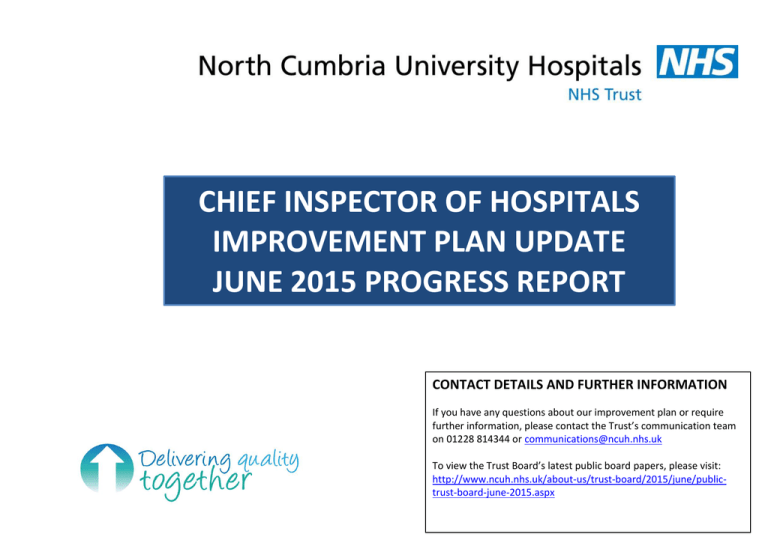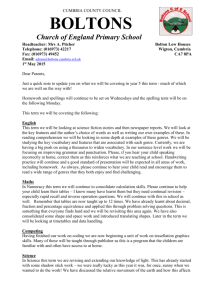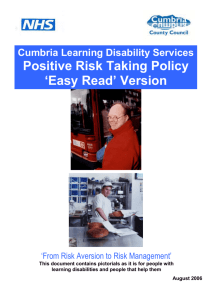CHIEF INSPECTOR OF HOSPITALS IMPROVEMENT PLAN UPDATE JUNE 2015 PROGRESS REPORT
advertisement

CHIEF INSPECTOR OF HOSPITALS IMPROVEMENT PLAN UPDATE JUNE 2015 PROGRESS REPORT CONTACT DETAILS AND FURTHER INFORMATION If you have any questions about our improvement plan or require further information, please contact the Trust’s communication team on 01228 814344 or communications@ncuh.nhs.uk To view the Trust Board’s latest public board papers, please visit: http://www.ncuh.nhs.uk/about-us/trust-board/2015/june/publictrust-board-june-2015.aspx Re-inspection The Trust was re-inspected by the CQC week commencing 30 March 2015. The inspection teams were on site on Tuesday 31 March at West Cumberland Hospital and Wednesday 1 April at the Cumberland Infirmary. The CQC team also had some time on site on the morning of Thursday 2 April for any outstanding queries. During the inspection the inspection team gathered information in a number of ways which included speaking to patients and people who use our services, holding focus groups with staff and interviewing individual directors as well as staff of all levels. The Trust is currently awaiting the report which will be published in due course. Success Regime North Cumbria is among first three health and care systems to be included in Success Regime, a new national initiative for challenged health economies. The Chief Executive of the NHS, Simon Stevens, has announced at the NHS confederation conference that the North Cumbria health system is to be one of the first three areas in England to receive specific support under the NHS 'Success Regime', a new national initiative for challenged health economies that is being jointly created by Monitor/NHS England/Trust Development Authority. North Cumbria is one of three areas initially selected along with Essex and North, East and West Devon, as these have been assessed as the most challenged health systems in England. For north Cumbria, this means that North Cumbria University Hospitals NHS Trust is part of the Success Regime along with Cumbria Partnership NHS Foundation Trust for services it provides in north Cumbria, NHS Cumbria Clinical Commissioning Group and Cumbria County Council. The purpose of this Success Regime is to protect and promote health and care services for patients in local health and care systems that are struggling with financial or quality problems, or sometimes both. CHIEF INSPECTOR OF HOSPITALS ‘MUST’ AND ‘SHOULD’ DO SUMMARY TRUST LEVEL REQUIRED MUST SHOULD 20 5 DELIVERED 31/3/15 MUST SHOULD 9 5 A&E 2 6 1 4 CRITICAL CARE MEDICINE 1 1 0 4 1 0 0 2 END OF LIFE SURGERY 2 5 1 4 2 3 2 3 MATERNITY 4 7 3 4 OUTPATIENTS 3 2 2 1 CHILDREN AND YOUNG PEOPLE 5 3 4 3 CUMMULATIVE TOTALS 43 32 25 24 WILL REMAIN ONGOING WITH SUPPORTING ACTION PLANS AS AT 31/03/2015 (9) Medical and nurse staffing levels (T1, T2) Planning services to meet best practice (T7) Clinical supervision & appraisals (T8, T20) Culture (T13) Estate and environment (T15, T17, T18) (3) Patient flow A&E standard (A&E1, A&E4) Triage ( A&E2) N/A (3) Patient flow in the hospital (MED1) Stroke and Diabetes care (MED4) Storage for large equipment (MED3) N/A (3) Patient flow and 18 Wk RTT (SUR4, SUR5) Standardisation of EPAU (SUR9) (4) Anaesthetic staffing cover (MAT1) Epidural (MAT2) Data system for maternity (MAT7) Normality in child birth (MAT6) (2) Waiting times and diagnostics (OP1 & OP5) (1) Children with mental health needs (CY4) 1. DELIVERY POSITION PER SERVICE LINE MUST & SHOULD DO’S FULLY DELIVERED BY 31/03/2015 MUST & SHOULD DO’S WHICH WILL REMAIN WORK IN PROGRESS WITH SUPPORTING ACTION PLANS AS AT 31/03/2015 TRUST LEVEL Must Do (9) T1 – medical staff numbers T2 – nursing staff levels T7 – planning of care and services in accordance with best practice T8 – Provide clinical supervision to all staff T13 – promote a culture that supports openness and transparency T15 – redress all estates and equipment deficits T17 – storage of equipment safely T18 – Action to prevent build up in dirty utility at CIC T20 – delivery of staff appraisals (73%) 20 Must Do 5 Should Do Must Do (9) T2 – review the use of the acuity tool T3 – clinical risk management T4 – Improve support given to junior med staff T11 – complaint information up to date T19 – porters at WCH training and guidance on security and restraint T5 – delivery of mandatory training T6 – Compliance with NICE and audit T14 – Ensure that Board assurance is supported by robust information T16 – emergency equipment Should Do (5) T4 – Improve support given to junior med staff T9 – Improve training with care bundles T10 – Continue to improve complaint responses T11 – complaint information up to date T12 – show how we have responded to feedback (you said we did) A&E 2 Must Do 6 Should Do Must Do A&E3 – A&E triage Should Do (4) A&E5 – Ensure adequate services for patients who are in A&E overnight A&E6 – Make improvements to the major haemorrhage protocol A&E7 – safety and security of visitors to A&E A&E8 – Improve CT reporting TARN Must Do (1) A&E1 – improve flow to reduce transfer delays, avoid patients in A&E overnight and delays. Should Do (2) A&E 2 – Paediatric triage A&E4 - Effective flow to reduce waiting times MUST & SHOULD DO’S FULLY DELIVERED BY 31/03/2015 MUST & SHOULD DO’S WHICH WILL REMAIN WORK IN PROGRESS WITH SUPPORTING ACTION PLANS AS AT 31/03/2015 CC Must Do (1) CC1 – Ensure children cared for in ICU receive care appropriate for their age Must Do N/A Must Do (1) MED1 - Improve patient flow across hospital to improve A&E Should Do (2) MED4 - Improve the management of people with diabetes and stroke in line with national guidance MED3 - Improve access to equipment and provide more suitable storage for larger pieces of equipment N/A 1 Must Do MED 1 Must Do 4 Should Do EOL 2 Must Do Should Do (2) MED2 – Take action to reduce patients being moved between wards at night MED5 – Improve the management of people living with dementia Must Do (1) EOL1 – Implement care plans to replace LCP. EOL3 – Address problem caused by ventilation in mortuary Should Do (1) EOL2 – Develop a clear vision and strategy N/A 1 Should Do SUR 5 Must Do 4 Should Do Must Do (2) SUR2 – Policies and procedures to support major incident for surgery are robust SUR3 – Develop standard governance system and dashboard for dissemination to all specialties SUR1 – Redress imbalance of elective work between sites Should Do (3) SUR6 – Major incident plan for surgery is tested SUR7 – Develop audit process for WHO checklist Must Do (2) SUR4 – improve flow to cope with routine and reduce waiting times SUR5 – 18 weeks RTT Should Do SUR9 – Lack of standardisation for Early Pregnancy SUR8 – PROMS MUST & SHOULD DO’S FULLY DELIVERED BY 31/03/2015 MUST & SHOULD DO’S WHICH WILL REMAIN WORK IN PROGRESS WITH SUPPORTING ACTION PLANS AS AT 31/03/2015 MAT Must Do (1) MAT1 – national guidelines for having an anaesthetist available e at WCH at all times for Obstetrics Must Do (3) MAT3 – Clear action plans for lack of second theatre MAT4 – Ensure maternity service reviews its identified risks MAT 5 – Ensure risk management processes are embedded Should Do (4) 4 Must Do 7 Should Do OP 3 Must Do 2 Should Do MAT8 – Ensure the service has the ability to undertake grade 3 sections MAT10 – Develop a local risk register for penrith birthing centre MAT11 – clarify the maternity service liaison committee MAT9 – Ensure there is a SLA for Penrith birthing centre with CPFT Must Do (2) OP2 – Improve how patient records are made available for outpatient clinic appointments OP3 – Take action to ensure that patient records are fully complete and up to date and are made available in a timely way for OP Should Do (1) OP4 – Ensure the infrastructure is in place before establishing additional outpatient clinics Should Do (1) MAT2 – Epidural service at CIC MAT7 - Improve the use of technology and data for maternity MAT6 – clarify a leadership role to promote normality in child birth Must Do (1) OP1 – Support outpatients to meet national targets and ensure records available Should Do (1) OP5 – Improve access to CT/MRI MUST & SHOULD DO’S FULLY DELIVERED BY 31/03/2015 MUST & SHOULD DO’S WHICH WILL REMAIN WORK IN PROGRESS WITH SUPPORTING ACTION PLANS AS AT 31/03/2015 CY Must Do (1) CY4 – Take action to protect the health and welfare of children with mental health needs 5 Must Do 3 Should Do Must Do (4) CY2 –Ensure children are consistently risk assessed at time of arrival into the department CY3 – Ensure the risk register for the hospitals children’s ward reflects the risks in the completed clinical audits CY5 – Ensure good practice in infection control is followed in the SCBU CY6 – Improve the standard of nursing records Should Do (3) CY1 – Improve infection control in SCBU CY7 Ensure staff are aware of and have access to a robust policy for transferring sick children CY8 – Ensure staff on children’s ward document whether children have been involved in their decisions about care and treatment Should Do N/A



